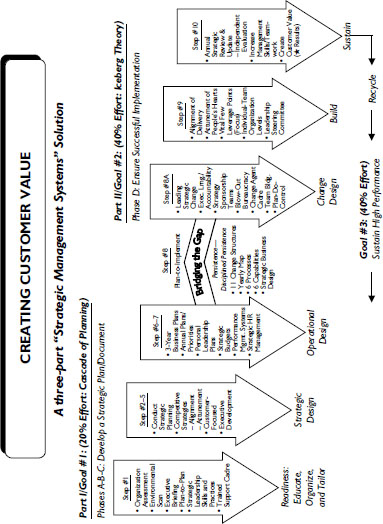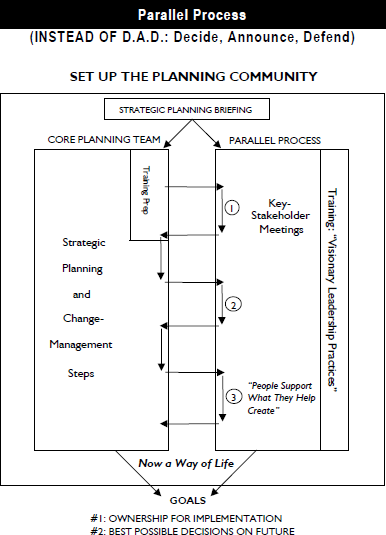I. Three Seemingly
Simple Elements
It is most important that you first get an understanding of the Three Seemingly Simple Elements that form the basis for our Systems Thinking Approach to transform and reinvent strategic management (planning and change) from its checkered past. For example, the number of corporate-planning jobs is rapidly decreasing. Planners have become an endangered species. Planning itself, however, has increased as senior executives try to make sense out of today’s turbulent and revolutionary times. Hence the need to reinvent planning and change management, and to do it wisely and effectively. The three simple elements described below will help you in your change effort.
The Systems Thinking Approach provides some very clear STRATEGIC ANSWERS to the questions asked of organizations who want to be successful in the long-term. However, there is no single answer—not even the reliance on Total Quality Management (TQM) or its successors, Business Reengineering, value chain management, or any other single management fad.
The closest we will come to finding a Holy Grail is what we find in Three Seemingly Simple Elements, described here:
Planning and Change are a part of Management and Leadership
An organization or team embarking on a strategic or business planning and change process must first ask itself: Is strategic planning:
(1) an event?
(2) a process?
(3) a change in our roles?
(4) a change in the way we run our business day-to-day?
While the complete answer is “all of the above,” strategic and business planning must be transformed into strategic management and culminate in a significant change in the way we do business. This is a key difference between our model and most others, which suffer from the often-fatal “SPOTS” Syndrome (Strategic Plans On Top Shelves, gathering dust). This is actually Strategic Answer #1: achieving our three goals by instituting a yearly Strategic Management Cycle and System. Strategic business plans are the blueprints; senior managers and department heads must change their behaviors and that of others to fill in the implementation details, based on a strategic perspective and a system.
Our model focuses on the arduous implementation of real change—a change in all the diverse human behaviors that collectively make up an organization’s culture. Changing human behavior in an entire firm or business unit to one in which the customer is paramount requires the continual reinforcement of new behaviors. You must counter the natural human tendency to revert back to the familiar behaviors and habits of the past.
Thus, it cannot be stressed too early that strategic and business planning and the implementation/change processes must be championed over the long haul by a “monomaniac with a mission”—the CEO or division/department’s top executive.
To achieve this, you must completely revamp your current management system. Our reinvented Strategic and Business Planning Model implements key concepts not found collectively in any other strategic planning/strategic change models.
THE GOALS
1. DEVELOP YOUR STRATEGIC AND/OR BUSINESS PLAN.
Begin with Plan-to-Plan. (Step 1)
Our “plan-to-plan” step #1 concept educates, organizes, and tailors the strategic or business planning process to the organization’s specific needs. It involves key stakeholders in the “Parallel Process” concept, and clarifies top executive roles in leading, developing, and owning the strategic plan. Alternatives to this approach are Strategic Planning Quick, Micro Strategic Planning, or Three-Year Business Planning processes for smaller organizations or divisions/major support departments, or when a fast jump-start implementation is critical during cost cutting, turnarounds, mergers, and similar events.
Conduct Actual Strategic Planning. (Steps 2–5)
The concept of an “Ideal-Future Vision” is the starting point for a Systems Thinking Strategic Management Process that helps clarify and implement tough choices. It focuses the organization and its core strategies on satisfying the customer—your only outcome or reason for existence.
These steps make up the blueprint for strategic design. They cover the development of organizational values or “culture,” the measurement of quantifiable outcome measures, and goals or Key Success Factors.
Lastly, they include the development of a Current-State Assessment. The core strategies are then developed to fill the gap between the Vision of the Future and what things look like today.
Conduct Operational Planning. (Steps 6–7)
Once strategic planning is completed, an organization must convert these longer-term, strategic decisions into operational ones. In larger organizations, this usually means first developing a three-year Business Plan (Step #6) for each strategic business unit or major program area. Every major support department (public or private) should have one, also. This includes Finance, HR, Marketing, Legal, and Administrative departments. This Business Planning process looks remarkably like the strategic planning process already described—Planto-Plan and a strategic design for the business unit. The main difference is that the Strategic Business Unit or Major Support Department/Program Area (in the Public Sector) must plan within the context of the overall larger strategic plan already developed.
Once these three-year Business Plans are developed, you must set up annual plans and strategic budgets that relate to annual actions and priorities (Step #7). Annual plans and budgets must be set within the context of the core strategies already developed. (To set separate department objectives is a big mistake; the objective of each department in every organization should be to support the core strategies of the overall organization.
2. ENSURE SUCCESSFUL IMPLEMENTATION
“Bridging the Gap: Plan-to-Implement
Plan-to-Implement Step #8 is designed to bridge the gap between strategic/business planning and the difficult implementation process. It is an educating, organizing, and tailoring day for the change effort. You must plan for such things as a Strategic Change Leadership Steering Committee, a yearly Comprehensive Map of the implementation process, and the use of cross-functional Strategy Sponsorship Teams. These are all part of the “44 Fail-Safe Mechanisms” that are reviewed during Step #8 to ensure successful Strategic Planning implementation.
Goal #2 also includes Step #9, Strategy Implementation and Change, where the actual work and tasks get accomplished. It includes the “Organization-asa-System” model. In order to make this complex implementation process easier, we have developed a Wheel of Detail comprised of eight key implementation areas and several specific detailed actions used in almost all large-scale, major cultural change efforts.
It also includes the need to (1) create Customer Value in your delivery system, (2) build the necessary Leadership Development System, and (3) institute strategic Human Resource Management practices to create the desired culture to support this delivery.
Both of these needs are crucial to the work of our organization, as well. While we don’t consult on all areas of organization development, we do focus on key leverage points.
3. CREATE AND SUSTAIN LONG-TERM HIGH PERFORMANCE
Annual Strategic Review (and Update)
Step #10 includes an Annual Strategic Review and Update, which is usually part of an annual independent financial audit. Strategic and Business Plans are often made for three to seven or more years at a time, but should be formally reviewed and updated yearly to keep pace with change. Strategic and business plans must be living and breathing documents. This is the only way to sustain high performance over the long-term.
In summary, this Three-Part/Three-Goal Systems Thinking Approach includes all the elements necessary to design and build a customer-focused, high-performance learning organization. However, our 10-Step Reinvented Strategic Management Planning and Change Model is key. It will be explained in more detail later.
“People Support What They Help Create”
In its first year of strategic and business planning, an organization must set in place the necessary strategic planning strategies and create a critical mass for the desired changes. A core planning team of eight to fifteen people from your collective leadership should lead the process, do the hard work, and make the decisions.
One crucial planning task is to do a Parallel Process (see next page’s graphic) that involves the rest of management and key stakeholders in a meaningful way. Gather their input on all draft documents and increase their ownership of the plan. This is the second element; people support what they help create.
![]() For Example
For Example
During the Hayward Unified School District Plan-to-Plan step, the Hayward, California district established a core planning team of 15 people. However, because whatever it does broadly impacts the lives of thousands of families, its work with key stakeholders included over 100 meetings involving 2000+ people.
There’s one other component to the involvement of key stakeholders: three-year Business Planning. It is essential that all key line and staff units ultimately develop their own three-year Business Plans under the umbrella of the overall strategic plan. This need to link levels of planning into one system is often overlooked—a serious omission.
This brings us to Strategic Answer #2: the need for Visionary Leadership Practices that radically differ from those adopted by tyrannical bosses of the past. Leaders at multiple levels, including trainers, coaches, and facilitators, are needed to carry out this Parallel Process during strategic planning, the 3-year Business Planning, and all strategic management and change processes. Everyone in a managerial position must acquire a wide range of participative management and leadership skills. The two extremes (Feared Bosses and Too Nice Bosses) must be avoided like the plague.
The only advantage an organization has over the long-term is its leadership. Employees become your greatest assets only if the leaders allow them to be. If leaders are to have the skills to do, leaders must help them develop a number of different skills and six levels of Natural Leadership competencies, including:
Level #1: Enhancing Your Self-Mastery
Level #2: Building Relationships
Level #3: Building Effective Teams
Level #4: Building Customer-Focused Business Processes
Level #5: Integrating Organizational Outcomes
Level #6: Creating Value for the Customer
This doesn’t happen overnight. Leadership is a contemplative art requiring a long-term commitment to it as a separate professional growth opportunity. The ability to lead an entire organization and all its facets and levels effectively is quite a daunting task, requiring a life-long learning perspective.
Thus, it is key for organizations to develop a fully comprehensive “Strategic Leadership Development System” to make certain that each leader develops these six core competencies.
Use Systems Thinking—Focus on Outcomes: The Customer
The key to the Systems Thinking Approach, as you will see in more detail later, is to focus on your outcomes. Begin with the end in mind and think backwards to achieve your future. For organizations, focusing on the most important outcome means focusing on the customer. This is STRATEGIC ANSWER #3: the need for every organization to 1) become an outcome-oriented system and 2) focus on the customer.
This common sense focus on the customer, however, is frequently not the way organizations view their missions. Organizations are often started because either someone invented a better mousetrap (i.e., a product to sell), invested capital (i.e., a profit motive), or secured a government-granted monopoly (i.e., a regulation orientation).
![]() For Example
For Example
Compare how your firm is driven vs. these six options by spreading 10 points across all six choices:
|
_____ |
(1) Regulatory; the “why” |
|
_____ |
(2) Operations; the “how” |
|
_____ |
(3) Profits; the “why” |
|
_____ |
(4) Products; the “what” |
|
_____ |
(5) Employees; the “how” |
|
_____ |
(6) Customers; the “who” |
If you selected Option (6) with the highest number of points as to how you are driven, then see the next list to verify if you really are driven by the characteristics of a Customer-Focused Organization.
We have copyrighted these characteristics into our Key Commandments of Customer-Focused Organizations, based on best-practices research in this area.
Assess how your organization matches up to these characteristics on a scale from 1 (Low)–10 (High):
Customer-Focused Organizations
|
______ |
1. |
They are close to the customer—especially senior executives, who meet and dialogue with them face-to-face on a regular basis out in the marketplace. |
|
______ |
2. |
Executives include the customers in their decisions, focus groups, meetings, planning, and deliberations. |
|
______ |
3. |
They know and anticipate the customers’ needs, wants, and desires as they change. |
|
______ |
4. |
Surpassing customer needs is the driving force of the entire organization. |
|
______ |
5. |
They survey customer satisfaction with their products and services on a regular basis. |
|
______ |
6. |
They hold a clear position in the marketplace vs. the competition (in the eyes of the customer). |
|
______ |
7. |
They focus on Creating Customer Value—i.e., “value-added” benefits to the customer through Quality products and services, Customer Choice, Responsiveness, delivery, speed, Service vs. Total Cost of doing business. |
|
______ |
8. |
They set quality customer-service standards—expectations that are specific and measurable to each department. |
|
______ |
9. |
The Customer Service Standards are based on customer input and focus groups. |
|
10. |
They require everyone in the organization to experience moments of truth by meeting and serving the customer directly … at least one day every year. | |
|
______ |
11. |
They focus and reengineer the business processes based on customer needs and perceptions … and do it across functions. |
|
______ |
12. |
They focus the organization structure on the marketplace— i.e., structure the organization by customer markets (1 customer = 1 representative). |
|
______ |
13. |
They reward customer-focused behaviors (especially cross-functional teams that work together to serve the customer). |
|
______ |
14. |
They have a clear policy … and the heavy use of recovery strategies to surpass customer expectations. |
|
______ |
15. |
They hire and promote “customer friendly” people. |
The focus of this guide is our Customer-Focused, Strategic Management Model, which has just been reinvented, based on:
(1) customer needs and desired outcomes
(2) extensive research in General Systems Theory
(3) the author’s professional experience
(4) practical application and refinement
Most importantly, however, is that this model is the result of a comprehensive literature search and a comparative analysis of 14 other popular strategic planning models. The most disturbing elements missing from all of these 14 models reviewed were a holistic approach and a focus on customer outcomes as the primary purpose of all enterprises.
THE ORGANIZATION AS A SYSTEM (from General Systems Theory)
Any organization is a living system—a complex network of inputs, interactions, processes, and outputs from employees, suppliers, and customers. Management and organizations need a set of concepts and tools for wiring, fitting, and aligning these concepts together with some sense of integrity of effort. Any organization will function best when all these interactions, processes, departments, and employees work together in an integrated, collaborative, and cross-functional fashion, supporting the firm’s overall Vision, Goals, Outputs, Results, and Purposes. (You pick the term; it does not matter.) It must be used to think, plan, act, and communicate throughout the organization.
The best way to describe any “system” is with a series of Inputs to a Process or Throughput that creates value added, to Outputs into the External Environment that the Customer will buy, use, desire, and appreciate. Those four characteristics, along with a Feedback Loop, comprise some of the main components of General Systems Theory (GST)— the most basic way to look at any living system.
When you use this Framework, it becomes obvious that satisfying your customer’s needs and wants should be the primary purpose or focus of your organization as a system (versus becoming enslaved by obsolete activities as ends in themselves). This is especially important for Public Sector and Not-For-Profit organizations, who do not have the profit motive to keep them focused on the customer and on outputs.


